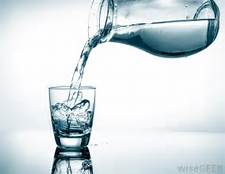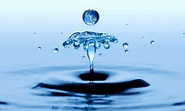Drink-Drank-Drunk











Drink - Drank - Drunk
If you have problems and drink less than 2 liter of water a day, you may be suffering from dehydration. Before or along with any other form of treatment, increase your water intake until you reach the two-liter mark.This may take several weeks or months, depending on how much water you are drinking currently. As with any change in diet or lifestyle, an increase in water intake should be done slowly.The kidneys need time to adapt and relearn how to process all this fluid. Usually you will begin to notice improvements in overall health as soon as you have been drinking more than four or five large glasses a day for at least a month.
If you want to start drinking more water but don't like the taste, you could try adding hydrosols; they are, after all, a good flavouring agent as well as being therapeutic, and unlike most flavourings, they are free of salt, sugar, and additives. Start by spritzing very small amounts into each glass of water you consume . Vary the hydrosols so that the health properties specific to each glass of water you consume. Vary the hydrosols so that the health properties specific to each one are not overwhelming.
You will soon notice a positive difference in how you feel. Convince yourself that you're drinking iced tea by adding a spritz of melissa combined with clary sage. Neroli and Rose are really good on their own. Bay leaf, sage, and rosemary are non-sweet options and make highly refreshing beverages, but avoid sage if you have high blood pressure.It will soon become a pleasure to drink "flavoured" water, and you may find that the occasional glass of unflavoured water becomes more appealing over time. Before you know it you will be downing water by the liter, with or without hydrosols, and your body will love you for it.
The consummate water drinker can feel that fluid as it enters the stomach, then the bloodstream, and can describe its progress throughout the arteries, cells, and tissues as surely as you can describe the flow of any river.You may find it easier to drink large quantities of water if it is at room temperature or barley cool rather than 1ce-cold. Research has shown that ice water can cause spasms in the stomach owing to the temperature shock. While there are times when cold water is desirable to reduce temperature rapidly, a sufficient quantity of neutral temperature water has the same effects and will not cause abdominal cramps. Warm or hot water can be used to stimulate peristalis in the bowel, or if drunk in very large amounts (with or without sea salt), it can work as an emetic causing vomiting.The prime time for drinking water are morning and evening. First thing in the morning drink two large glasses thirty minutes before breakfast or your usual morning beverage.
This stimulates elimination and acts like an internal shower, waking up the body and preparing it for activity. In the evening, drink a large glass about thirty minutes before retiring, which will allow you time to relive yourself before sleep. Additional water should be consumed before rather than during meals to improve digestion, makes the appetite more stable, and facilitate elimination.
If the water is drunk before eating, it also helps dilute the hydrolic acid in the stomach, making the food bolus less acidic when it passes into the small intestine. drinking during a meal means that the food itself will absorb the water and swell, contributing to the overstuffed feeling so many people experience after eating. Water should also preface any physical exertion or a gym workout and is highly beneficial for those working in environments lacking fresh air, such as closed-system office buildings. Supplying the body with adequate water to prevent dehydration is critical, and the immediate perceivable effects include increased energy, improved digestion, enhanced mental function, balanced metabolism and sometimes weight loss, improved circulation, healthier or younger looking skin, and for some, an increased libido.
The effects of dehydration from chronic water shortage in the body include fatigue, poor digestion and constipation, stressed liver and kidneys, headaches, muscle spasms, and cramps, uric acid buildup, gout, even arthritis has been linked to dehydration. If your blood is 90% water and each blood cell is 68 percent water, imagine the stress on your heart as the blood becomes dehydrated and thickens because of its decrease in volume. If the lymph, so integral to the immune system, is 94 percent water, how strong is your immunity to the flu when dry winter air and central heating dehydrate your entire being, including the lymph? If the liver is nearly 72 percent water, no wonder you get a hangover when you drink dehydrating alcohol and don't re-balance the organ with pure water. Thirst and dry mouth are not the first messages the body sends, and it is only when we start re-hydrating ourselves that we begin to realize what we have been missing.
Reference: Hydrosols - The Next Aromatherapy: Suzanne Catty
Blue Babies









BLUE BABIES
Not only did toxic waste spills from these CAO farms damage local waterways for up to a hundred miles, but they also killed tens of thousands of fish and other water life, deposited toxic silt in riverbeds that can continually repollute any time the silt is disturbed. Not only did toxic waste spills from these CAO farms damage local waterways for up to a hundred miles, but they also killed tens of thousands of fish and other water life, deposited toxic silt in riverbeds that can continually repollute any time the silt is disturbed, and created seepage into ground- and well water used for human consumption.
A 1995 study in the area found "ammonia-N concentrations up to 300 mg/L and nitrate-N of 3.3 mg/L or less. The EPA's drinking water standard for well water is 10mg/L of nitrate or less, a limit designed to prevent an infant blood disorder known as "blue baby syndrome,' or methemoglobinemia. In the body nitrate is reduced to nitrite, which converts hemoglobinemia to methemoglobin, making red blood cells unable to carry oxygen."
There are endless statistics on the plight of the world's water, and it is a major agenda item for the United Nations, the World Health Organization, the government of most countries, and the political platform of every environmental and humanist organization around. It is also an issue for every human being and for Gaia herself.
We need water; we must start valuing and respecting it before it's too late. But I don't mean to be all doom and gloom. Water does wonders, and there are some truly wonderful waters out there. Even more interesting is that research into the healthy effects of certain water treatments has found no difference in efficacy between spa waters and regular tap water. All is not lost!
Reference: Hydrosols The Next Aromatherapy : Suzanne Catty
Supply and Demands









SUPPLY AND DEMANDS
Regarding water supply and availability, Sandra Postel, director of the Global Water Policy Project in Massachusetts, writes, "Many major rivers now run dry for large portions of the year, including the Yellow in China, The Indus in Pakistan, the Ganges in South Asia and the Colorado in the America Southwest. Worldwide, one in five acres (two hectares) is damaged by a buildup of salt that is slowly sapping the soil's fertility.
The number of people living in water-stressed countries is projected to climb from 470 million to three billion by 2025." as Postel points out, the pollution of the land through lack of adequate water is a huge problem and is compounded by the fact that much of the water that does percolate through the soil has a negative effect because of pollutants, rather than the cleansing effect one would imagine.
America Scientists published a twelve-page article titled "Impacts of industrial Animal Production on Rivers and Estuaries" that focuses on North Carolina, the second-largest hog production state in the United States and an area of complex environmental regions, including many coastal floodplains and watersheds.
These areas are where many of the CAOs, or concentrated animal operations, are located, and their effects and demands upon the local environment have been devastating. In 1997 the North Carolina General Assembly placed a two-year moratorium (recently extended for a third year) on the construction of new concentrated animal operations as a result of the pollution and waste-lagoon spills from these facilities.
Reference: Hydrosols The Next Aromatherapy : Suzanne Catty
Water Quality








WATER QUALITY
For those who do drink water, the current choice becomes one of source. Do we drink tap-,filtered, or distilled water? Bottled water is popular these days, as we are forced to address our concerns for health and worry about the ability of modern water processing to successfully remove all the pollutants from our municipal supplies. But not all bottled water is created equals we shall see.
In the spring of 2000, the town of Walkerton, Ontario, experienced an outbreak of E.coli in its drinking water. At least eleven people died, and a number of other deaths may have been linked to the outbreak. Hundreds ended up in hospitals and doctor's offices, and the ongoing investigation indicates that at least some levels of government were warned of the problem months, perhaps years, before it hit the critical point.
In the United States, the EPA (Environmental Protection Agency) has reported that much of the tap water may contain a wide variety of pharmaceutical drugs passed on from humans through their urine, as well as toxins seeping in from agricultural sources. There is even an urban legend in circulation that Seattle's water supply is now caffeinated due to the enthusiastic coffee consumption of that city!
Cryptosporidium is a waterborne parasite that lives in animals and can be passed into water sources through their waste. It has been found in rivers, lakes, reservoirs, and other types of surface water. In 1993 cryptosporidium in the water supply caused four hundred thousand residents of Milwaukee to become ill with flulike symptoms, and some of the very young and very old victims died.
Later that year, a failure of Washington, D.C.'s filtration process caused elevated turbidity (particulate matter in the water)and an increase in gastrointestinal complaints. No wonder people are turning to bottled water. Bottled water may come from underground aquifers, springs, wells, and other deep-water sources that are protected from the environment and tested for purity.
These waters are the product of hundreds of thousands of years of natural filtration and purification by the planet and are the most desirable waters for health purposes. Bottled water may also be taken from surface, subsurface, or shallow groundwater, lakes and streams; or approved municipal supplies. Water from these sources is subject to purification processes according to government regulations.
The centres for Disease Control (CDC) in Atlanta recommends reverse osmosis, one-micronabsolute filtration, ozonation, and distillation as the preffered method for purifying municipal and surface water. As far as shelf life is concerned, in some countries it is two years from the date of bottling, regardless of whether the packaging is glass or plastic. Plastic bottles have been suspected of releasing toxins (phalates)into the products they carry, but most of the data find no problem with water in plastic, owing to its generally nonreactive nature.
Clean water and where to find it is the big problem. The questions remaining are: How safe and effective is modern water filteration? How reliable are the tests being done? Trihalomethanes (THMs), the best known of which is chloroform, are suspected of being carcinogenic and can be created when chlorine is added during water treatment and it interacts with organic matter in suspension.
Areas where the municipal water sources are surface or subsurface , such as lakes, rivers, and shallow groundwater, contain the highest quantities of organic matter and are the most likely to develop THMs. The more time there is between water treatment and delivery, the more concentration increases, and it continues to increase as long as "free chlorine residuals " are present - a case of more chlorine than is necessary being added to the water.
High pH levels and warm temperatures also increase formation of THMs, which means that summer months show higher counts in drinking water and that hot water is more likely to contain these toxic chemicals. Researchers in California have linked a likelihood of miscarriage with high THM counts in drinking water, and the studies have been repeated in Canada with similar findings on both miscarriages and stillbirths, reported in the professional journal Epidemiology.
Reference: Hydrosols The Next Aromatherapy : Suzanne Catty
Articles - Most Read
- Home
- What are Hydrosols
- What are Hydrosols-2
- The Monographs
- How to Make a Hydrosol
- Table of Common Latin Names and pH Values - F - O
- Distilled or Extracted Specifically For Therapeutic Use - 3
- Kurt Schnaubelt
- What isn't a Hydrosol?
- Table of Common Latin Names and pH Values - P - S
- Wholly Water!
- Blue Babies
- Supply and Demands
- Mature Skin
- Recipes Alpha F
- Hydrosols In The Marketplace
- Chemicals: Friends or Foes?
- Hemorrhoids
- Nelly GrosJean
- Water as Medicine
- The Educated Consumer
- Genitically Modified Plants
- Influences
- Water Quality
Articles-latest
- Daucus carota/Wild Carrot Seed - pH 3.8-4.0
- Cupressus sempervirens/ Cypress-pH3.5-3.7
- Coriandrum sativum/Coriander Herb-and-Seed
- Comptonia peregrinal/Sweet Fern- pH 3.8
- Citrus clementine (fe) Clementine Petitgrain- pH 4.3-4.4
- Citrus aurantium var. amara (flos) /Neroli Orange Blossom-pH3.8-4.5
- Cistus ladaniferus/Rock Rose-pH 2.9-3.1
- Cinnamomum zeylanicum (ec) Cinnamon Bark-pH3.3
- Chamaemelum nobile/Roman Chamomile - pH 3.0-3,3
- Centaurea cyanus/Cornflower/Bachelor's Button-pH 4.7-5.0
- Cedrus atlantical/Cedarwood/Atlas Cedar-pH 4.1- 4.2
- Hydrosols -The PH - Anomalies
- Hydrosols- Establishing Shelf Life and Stability
- Boswellia carterii/FRANKINCENSE
- Asarum canadense/ Wild Ginger/Canadian Ginger
- Artemesia vulgaris / Artemesia
- ARTEMESIA DRACUNCULUS - TARRAGON
- Angelica archangelica / Angelica Root - Hydrosols
- The Key, or More Correctly, the pH - 2 - Hydrosols
- The Key, or More Correctly, the pH-Hydrosols
- The Hard pHacts - Hydrosols
- Calamus Root/Sweet Flag - ACORUS CALAMUS
- Yarrow - Achillea millefolium - Hydrosols
- Balsam Fir - Abies balsamea - Hydrosols

